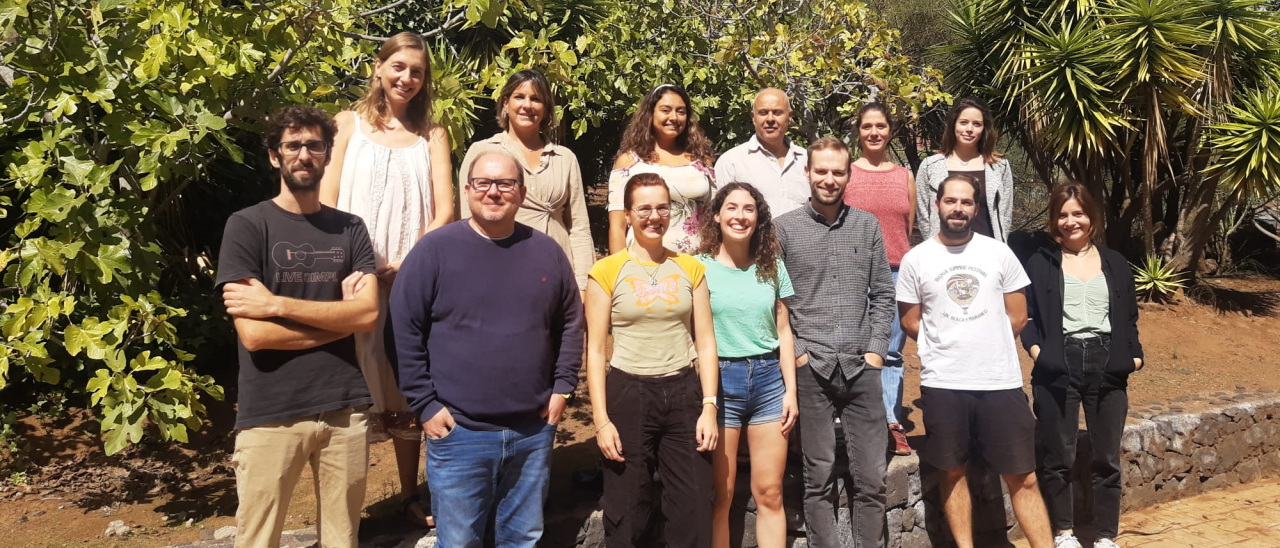Subvenciones relacionadas:
General
Bienvenida a la página web del grupo de investigación Traces of Galaxy Formation.
Somos un grupo de investigación amplio, diverso y muy activo cuyo objetivo principal es entender la formación de galaxias en el Universo de una manera lo más completa posible. Con el estudio detellado de las poblaciones estelares como bandera, estamos constantemente buscando y desarrollando nuevas herramientas e ideas que nos permitan entender cómo las galaxias han llegado a convertirse en lo que hoy observamos.
Una historia de formación compleja, como la que se espera describa la evolución de las galaxias, necesita de un acercamiento multidisciplinar para ser entendida. Nuestro grupo en el IAC está compuesto por personal investigador de gran experiencia en simulaciones cosmológicas, estudios dinámicos, análisis de poblaciones estelares y caracterizaciones morfológicas de galaxias tanto locales como a alto corrimiento al rojo. Combinamos distintas alternativas (e.g. observaciones y teoría o procesos de evolución secular y cosmológica) para poder alcanzar en los próximos años una visión consistente de los mecanismos físicos que regulan la formación de las galaxias.
Dentro de este esquema general, estamos principalmente centrados en el estudio de tres líneas centrales:
- Modelos de síntesis de poblaciones estelares
- Desarrollo de modelos de poblaciones estelares
- Métodos de análisis para el estudio de poblaciones estelares
- Universalidad de la función inicial de masa (IMF)
- Evolución cósmica de galaxias
- Evolución de galaxias masivas
- Poblaciones estelares en distintos entornos
- Ciencia a bajo brillo superficial
- Simulaciones númericas y aprendizaje automático
- Procesos evolutivos en galaxias cercanas
- Agujeros negros como moduladores de la formación estelar
- Cartogrtafiados locales
- Cinemática estelar y modelos dinámicos
Si quieres ponerte en contacto o trabajar con el grupo, por favor, envía un correo al investigador principal (Ignacio Martín-Navarro ignacio.martin [at] iac.es (ignacio[dot]martin[at]iac[dot]es)).
Miembros
Resultados
Esta es una muestra de algunos de nuestros resultados destacados más recientes:
- Local variations of the stellar velocity ellipsoid - II. The effect of the bar in the inner regions of Auriga galaxies. Walo et al. 2022, MNRAS (https://ui.adsabs.harvard.edu/abs/2022MNRAS.513.4587W)
- Anisotropic satellite galaxy quenching modulated by black hole activity. Martín-Navarro et al. 2021, Nature (https://ui.adsabs.harvard.edu/abs/2021Natur.594..187M)
- Evaluating hydrodynamical simulations with green valley galaxies. Angthopo et al. 2021, MNRAS (https://ui.adsabs.harvard.edu/abs/2021MNRAS.502.3685A)
- Sub one per cent mass fractions of young stars in red massive galaxies. Salvador-Rusiñol et al. 2020, Nature Astronomy (https://ui.adsabs.harvard.edu/abs/2020NatAs...4..252S)
- Detection of young stellar populations in apparently quenched low-mass galaxies using red spectral line indices. de Lorenzo-Cáceres et al. 2020, MNRAS (https://ui.adsabs.harvard.edu/abs/2020MNRAS.498.1002D)
Actividad científica
Publicaciones relacionadas
-
Massive Relic Galaxies Challenge the Co-evolution of Super-massive Black Holes and Their Host GalaxiesWe study a sample of eight massive galaxies that are extreme outliers (3–5σ) in the {M}\bullet ‑ Mbulge local scaling relation. Two of these galaxies are confirmed to host extremely large super-massive black holes (SMBHs), whereas the virial mass estimates for the other six are also consistent with having abnormally large SMBHs. From the analysisFerré-Mateu, A. et al.
Fecha de publicación:
72015 -
The BaLROG project - I. Quantifying the influence of bars on the kinematics of nearby galaxiesWe present the BaLROG (Bars in Low Redshift Optical Galaxies) sample of 16 morphologically distinct barred spirals to characterize observationally the influence of bars on nearby galaxies. Each galaxy is a mosaic of several pointings observed with the integral-field unit (IFU) SAURON leading to a tenfold sharper spatial resolution (˜100 pc)Seidel, M. K. et al.
Fecha de publicación:
72015 -
The initial mass function of a massive relic galaxyMassive relic galaxies formed the bulk of their stellar component before z ˜ 2 and have remained unaltered since then. Therefore, they represent a unique opportunity to study in great detail the frozen stellar population properties of those galaxies that populated the primitive Universe. We have combined optical to near-infrared line-strengthMartín-Navarro, I. et al.
Fecha de publicación:
72015 -
Virgo cluster and field dwarf ellipticals in 3D - III. Spatially and temporally resolved stellar populationsWe present the stellar population analysis of a sample of 12 dwarf elliptical galaxies, observed with the SAURON integral field unit, using the full-spectrum fitting method. We show that star formation histories (SFHs) resolved into two populations can be recovered even within a limited wavelength range, provided that high signal-to-noise ratio (SRyś, A. et al.
Fecha de publicación:
92015 -
Constraints on the evolutionary mechanisms of massive galaxies since z ∼ 1 from their velocity dispersionsSeveral authors have reported that the dynamical masses of massive compact galaxies (M* ≳ 1011 M⊙, re ∼ 1 kpc), computed as Mdyn = 5.0 σe2 re/G, are lower than their stellar masses M*. In a previous study from our group, the discrepancy is interpreted as a breakdown of the assumption of homology that underlie the Mdyn determinations. Here, weSánchez-Bláquez, P. et al.
Fecha de publicación:
102015 -
IMF&ndashMetallicity: A Tight Local Relation Revealed by the CALIFA SurveyVariations in the stellar initial mass function (IMF) have been invoked to explain the spectroscopic and dynamical properties of early-type galaxies (ETGs). However, no observations have yet been able to disentangle the physical driver. We analyze here a sample of 24 ETGs drawn from the CALIFA survey, deriving in a homogeneous way their stellarMartín-Navarro, I. et al.
Fecha de publicación:
62015 -
Central star formation and metallicity in CALIFA interacting galaxiesWe use optical integral-field spectroscopic (IFS) data from 103 nearby galaxies at different stages of the merging event, from close pairs to merger remnants provided by the CALIFA survey, to study the impact of the interaction in the specific star formation and oxygen abundance on different galactic scales. To disentangle the effect of theBarrera-Ballesteros, J. K. et al.
Fecha de publicación:
72015 -
Formation of S0 galaxies through mergers. Explaining angular momentum and concentration change from spirals to S0sThe CALIFA team has recently found that the stellar angular momentum and concentration of late-type spiral galaxies are incompatible with those of lenticular galaxies (S0s), concluding that fading alone cannot satisfactorily explain the evolution from spirals into S0s. Here we explore whether major mergers can provide an alternative way toQuerejeta, M. et al.
Fecha de publicación:
72015 -
The trace of a substantial assembly of massive E-S0 galaxies at 0.8 < z < 1.5 in galaxy number countsK-band galaxy number counts (GNCs) exhibit a slope change at K ˜ 17.5 mag not present in optical bands. To unveil the nature of this feature, we have derived the contribution of different galaxy types to the total K-band GNCs at 0.3 z 1.5 by redshift bins and compared the results with expectations from several galaxy evolutionary models. We showPrieto, M. et al.
Fecha de publicación:
82015 -
Evidence for temporal evolution in the M33 disc as traced by its star clustersWe present precision radial velocities and stellar population parameters for 77 star clusters in the Local Group galaxy M33. Our Gran Telescopio de Canarias and William Herschel Telescope observations sample both young, massive clusters and known/candidate globular clusters (GCs), spanning ages ˜106-1010 yr, and metallicities, [M/H] ˜ -1.7 to solarBeasley, M. A. et al.
Fecha de publicación:
82015 -
A SLUGGS and Gemini/GMOS combined study of the elliptical galaxy M60: wide-field photometry and kinematics of the globular cluster systemWe present new wide-field photometry and spectroscopy of the globular clusters (GCs) around NGC 4649 (M60), the third brightest galaxy in the Virgo cluster. Imaging of NGC 4649 was assembled from a recently obtained Hubble Space Telescope/Advanced Camera for Surveys mosaic, and new Subaru/Suprime-Cam and archival Canada-France-Hawaii TelescopePota, V. et al.
Fecha de publicación:
62015 -
CALIFA, the Calar Alto Legacy Integral Field Area survey. III. Second public data releaseThis paper describes the Second Public Data Release (DR2) of the Calar Alto Legacy Integral Field Area (CALIFA) survey. The data for 200 objects are made public, including the 100 galaxies of the First Public Data Release (DR1). Data were obtained with the integral-field spectrograph PMAS/PPak mounted on the 3.5 m telescope at the Calar AltoGarcía-Benito, R. et al.
Fecha de publicación:
42015 -
Bar pattern speeds in CALIFA galaxies. I. Fast bars across the Hubble sequenceContext. The bar pattern speed (Ωb) is defined as the rotational frequency of the bar, and it determines the bar dynamics. Several methods have been proposed for measuring Ωb. The non-parametric method proposed by Tremaine & Weinberg (1984, ApJ, 282, L5; TW) and based on stellar kinematics is the most accurate. This method has been applied so farAguerri, J. A. L. et al.
Fecha de publicación:
42015 -
Stellar population synthesis models between 2.5 and 5 μm based on the empirical IRTF stellar libraryWe present the first single-burst stellar population models in the infrared wavelength range between 2.5 and 5 μm which are exclusively based on empirical stellar spectra. Our models take as input 180 spectra from the stellar IRTF (Infrared Telescope Facility) library. Our final single-burst stellar population models are calculated based on twoRöck, B. et al.
Fecha de publicación:
52015 -
Evolutionary stellar population synthesis with MILES - II. Scaled-solar and α-enhanced modelsWe present models that predict spectra of old- and intermediate-aged stellar populations at 2.51 Å (FWHM) with varying [α/Fe] abundance. The models are based on the MILES library and on corrections from theoretical stellar spectra. The models employ recent [Mg/Fe] determinations for the MILES stars and BaSTI scaled-solar and α-enhanced isochronesVazdekis, A. et al.
Fecha de publicación:
52015 -
A cosmological context for compact massive galaxiesTo provide a quantitative cosmological context to ongoing observational work on the formation histories and location of compact massive galaxies, we locate and study a sample of exceptionally compact systems in the BOLSHOI simulation, using the dark matter structural parameters from a real, compact massive galaxy (NGC 1277) as a basis for ourStringer, M. et al.
Fecha de publicación:
52015 -
The initial mass function of early-type galaxies: no correlation with [Mg/Fe]The initial mass function (IMF) of early-type galaxies (ETGs) has been found to feature systematic variations by both dynamical and spectroscopic studies. In particular, spectral line strengths, based on gravity-sensitive features, suggest an excess of low-mass stars in massive ETGs, i.e. a bottom-heavy IMF. The physical drivers of IMF variationsLa Barbera, F. et al.
Fecha de publicación:
42015 -
Stellar Kinematics and Structural Properties of Virgo Cluster Dwarf Early-type Galaxies from the SMAKCED Project. III. Angular Momentum and Constraints on Formation ScenariosWe analyze the stellar kinematics of 39 dwarf early-type galaxies (dEs) in the Virgo Cluster. Based on the specific stellar angular momentum λRe and the ellipticity, we find 11 slow rotators and 28 fast rotators. The fast rotators in the outer parts of the Virgo Cluster rotate significantly faster than fast rotators in the inner parts of theToloba, E. et al.
Fecha de publicación:
22015 -
Further evidence for a time-dependent initial mass function in massive early-type galaxiesSpectroscopic analyses of gravity-sensitive line strengths give growing evidence towards an excess of low-mass stars in massive early-type galaxies (ETGs). Such a scenario requires a bottom-heavy initial mass function (IMF). However, strong constraints can be imposed if we take into account galactic chemical enrichment. We extend the analysis ofVazdekis, A. et al.
Fecha de publicación:
32015 -
Discovery of true, likely and possible symbiotic stars in the dwarf spheroidal NGC 205In this paper we discuss the photometric and spectroscopic observations of newly discovered (symbiotic) systems in the dwarf spheroidal galaxy NGC 205. The Gemini Multi-Object Spectrograph on-off band [O III] 5007 Å emission imaging highlighted several [O III] line emitters, for which optical spectra were then obtained. The detailed study of theGonçalves, D. R. et al.
Fecha de publicación:
22015



